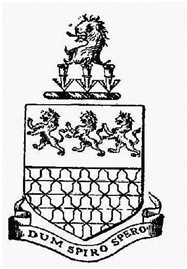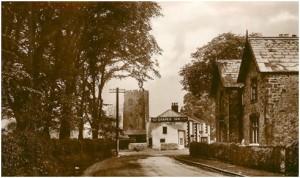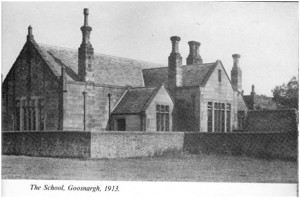
While I breathe, I hope.
The village of Goosnargh, which lies in Lancashire, in the north west of England, is situated seven miles from Preston the nearest market town. It is a very old parish first named in the Domesday Book of 1086. It has an ancient church, the village inn (there once was two) and a village green, the archetypal English village scene, hardly changed today.

In the north eastern part of the Churchyard are tombstones which mark the family vault of the Oliverson family, built in 1846 by Christopher Oliverson, a Yeoman of Westfield House, who died in 1852.
One such inscription reads:
Sacred to the memory of Richard Oliverson, late of Goosnargh, who departed this life on the 24th of November, 1799 in the 53rd year of his life.
Such was their affection for the village, those members who had long since moved away had chosen Goosnargh churchyard for their final resting place such as
Sacred to the memory of Richard Oliverson, late of Portland Place, London, son of Richard and Elizabeth Oliverson, who departed this life on the 28th of February, 1952 in the 77th year of his age.
Who were this family so revered in this small village? The first recorded Oliverson in the parish records is the burial of Elizabeth Oliverson, daughter of Richard Oliverson on 2 December 1644. There may have been Oliversons in Goosnargh before this as the first recorded Oliverson in the lineage in Burke’s Family Records is Richard Oliverson who died before 1668 who could have been her father. Their line of descent goes down to the twentieth century in Goosnargh. The parish records show their occupations as yeomen, husbandmen and gentlemen and in 1778 Christopher Oliverson is listed as a churchwarden. Christopher and Richard Oliverson were also members of the 24 sworn men in 1877. In the 1851 Barrett’s trade directory, Christopher and Thomas Oliverson are named as two of the principal landowners of Goosnargh along with such worthies as Thomas Batty Addison, the Recorder of Preston and James Sidgreaves Esq. The Oliverson family were known as the “Patrons of Goosnargh” as they were constant donors to the church and the school which was eventually named after them. In the church tower was a clock given by William Shawe Esq. and Richard Oliverson in 1846. An organ was presented in 1856 which bore the inscription:- “This clock erected AD 1861 at the joint expense of William Shaw Esq. of Preston and Richard Oliverson of Goosnargh and by them presented to Goosnargh Church. Simpson Makers, Preston."
The largest benefactor to the village was Richard Oliverson of Portland Place, London but formerly of Goosnargh, one of the five sons of Richard and Elizabeth Oliverson. He gained an MA at Exeter College, Cambridge and was a Director of the Scottish Fire and Life Insurance Company. Although he was based in London he was the principal benefactor of the family, one of his achievements being in 1840 he founded a school for girls at Goosnargh funded by subscription and the list included donations by his siblings Christopher, Agnes, Richard, Thomas and Robert Oliverson of London of £94 10s. The total amount raised amounted to £324 8s 0d. Back in 1834 he purchased land on the north side of Goosnargh Lane near to the church for the erection of a school house and prior to his death in 1852 he had conveyed to trustees for the use or benefit of the Master of the Free School for the time being. The subscription list for the girl’s school included donations by his siblings Christopher and Miss Agnes Oliverson of Goosnargh, and Richard, Thomas and Robert Oliverson of London, amounting to £142. Richard also made generous contributions to the establishment of a School Lending Library, adding 400 volumes of books from his own library. Further donations included a dwelling house for the use of the mistress of Goosnargh Girl’s School and about 12 months previous to his death he proposed to invest money, the interest of which to be applied in purchasing reading books for the use of the scholars of the Masters’ Free School. Although his life and work was in London, he never forgot the education he received at the school and his gratitude can be summed up by the impressive total of £2334 19s 1d he invested in the village.
His brother Robert was one of the largest brokers and underwriters in the city of London, his connection with the Lloyds establishment going back to 1817 and his wealth was estimated as about a million sterling.
In 1867 when the church was in much need of repair a subscription list was raised to fund the necessary work and three of the Oliverson family, Robert and his nephews Richard and Thomas were the main donors, their donations amounting to £250.
In 1869 there was great excitement in the village when Christopher Oliverson, the 34-year-old son of the late Christopher and Elizabeth Oliverson was to be married in the local parish church. The Preston Chronicle in an article headed “Marriage Festivities at Goosnargh” said that “there were great rejoicings in the village ... Early on the Wednesday morning the place assumed a lively aspect, and as the day advanced, affairs wore quite a holiday appearance. At half past ten several persons-principally females were in the church; and as the hour approached the sacred edifice was comparatively crowded.” One of the reasons for the rejoicing was that Christopher was to marry Jane Graham, the fifth daughter of John Graham, the Governor of Goosnargh Hospital. The paper went on to describe the scene: “From the steeple of the old church the union jack floated bravely; from each gable of the church yard there was an arch of evergreens, flanked with banners, and bearing in the centre the motto ‘May they be happy’. People had come from Preston and other parts of the district. The church looked especially well as it had recently been much improved, much of it from the benefice of the Oliverson family. The bell ringers were mentioned; five having been in the ‘trade’ for between thirty and forty years pulled bravely at the ropes. And if the chimes they rung out were not very harmonious, they were at least strong and hearty.
“Mr R Cookson, the schoolmaster who had helped to ring the bells when the first child of Mr Graham was born, pulled ‘jubilantly’ for a time one of the ropes in the ancient steeple and infused a spirit of festal hilarity into the school children who gathered to witness the marriage. At eleven the wedding party appeared, five bridesmaids who were the sisters of the bride were attired in lavender coloured silk dresses. The bride wore a dress of white silk; upon her head was a wreath of orange blossoms. In the chancel were Mr & Mrs Graham, Mrs Oliverson, Mr R Oliverson, London; Captain and Mrs Berry, Canterbury; Mr Alderman Arkwright, Preston; Mrs Hudson, Preston and others. The service was officiated by the Rev. Thomas Benn, vicar of Inglewhite. The organist for the day was Jane’s brother, Daniel Graham who played an appropriate musical prelude on the organ – a neat instrument given by Mr Robert Oliverson (uncle of the bridegroom) in 1836.”
It was said that a spirit of festivity prevailed in both the Hospital and the village, and there was no doubt that in the nineteenth century Goosnargh was renowned for its festivals which attracted people from the surrounding districts and beyond.
Christopher was the only one of the younger generation to settle in Goosnargh. After attending school in London he returned to marry his wife Jane and in 1871 is a landowner living at Whittingham House. After his death in 1877 at the age of 41, his widow moved to Goosnargh Lodge with her three children. Goosnargh Lodge was once the summer seat of the Oliverson family. She did not stay long, moving first to Blackpool and then to Southport where she died in 1918. Christopher’s brother Richard Oliverson was educated at Oxford and was barrister at law of the Inner Temple and married in 1863 Frances Ellen, daughter of Richard Almack of Melford Suffolk. He was also a JP in Lancaster. One of his sons Cecil Henry, was also a barrister at law of the Inner Temple and gained a BA Christ Church, Oxford.
Towards the end of the 19th century the last of the Oliverson family left Goosnargh, leaving behind a lasting legacy to the village and as Richard Cookson writing in 1887 in “Goosnargh Past and Present” said “When will we see their like again”.
For such a prominent family who had such an influence in the area it seems strange that no photographs appear anywhere of any of their members and they seem to have disappeared without trace after leaving the village. I have scoured family trees but information on the Oliversons is very scant indeed.
The tombstones in the churchyard and the village school to which they gave their name “Goosnargh Oliversons C E School” are the only permanent reminders.

Janet Rigby
Member 1314